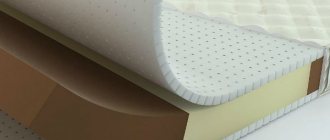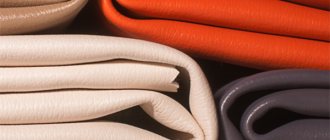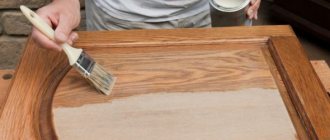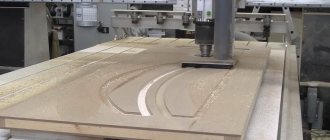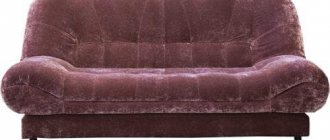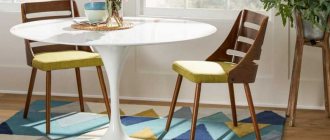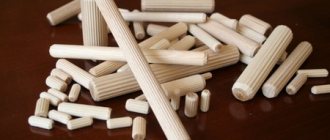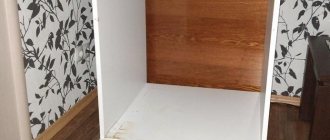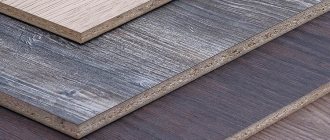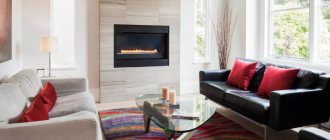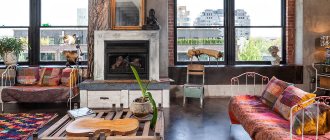Properties and production[edit | edit code]
Urea resins modified with melamine are used as a binding element. This ensures very low formaldehyde emissions, comparable to those of natural wood (formaldehyde emission class - E1). According to Russian GOST, the formaldehyde content for MDF class E-1 should correspond to no more than 8 mg/100 g (research using the perforator method)[1].
Industrial production of MDF began in the USA in 1966. In Russia, production began in 1997. The leader in MDF production in the world is China.
During the production process, MDF can be given special properties: fire resistance, biostability, water resistance.
Produced in thicknesses from 2 to 60 mm. The density of the material ranges from 600 to 800 kg/m³.
Laminated MDF
The finished facade is covered with decorative paper impregnated with melamine resin. The adhesive used for lamination polymerizes during the drying process, ensuring the strength of the top layer. Laminated MDF and chipboard are the most popular materials for the kitchen, as they are the most affordable.
Laminated boards imitate wood - any species and color. Bent facades are not produced using this technology, but milled ones are quite successful. Moreover, sometimes it is more difficult to find exactly even sashes made of this material.
Advantages:
- low cost;
- additional decorativeness does not affect the price;
- The range of possible colors is very large.
Flaws:
- fragility - melamine film is overly sensitive to moisture, so in the kitchen its service life is limited;
- Do not wash facades with aggressive chemicals;
- Abrasive cleaning products are also excluded.
Perhaps this is due to the traditional warm colors chosen for such facades, but consumer reviews are clear: laminated MDF looks cheap. In addition, lamination does not allow the material to demonstrate its useful qualities - durability and strength, since the film is damaged much earlier than the base wears out. The photo shows a kitchen made of laminated MDF.
Laminated material can be painted. Or resort to an even more beautiful technique - patination.
What does this abbreviation mean?
It is simply impossible to decipher the abbreviation in Russian, since the name was simply taken and copied from English - MDF, or Medium Density Fiberboard, which translates as medium density fiber board. If desired, you can add a small clarification: wood fiber.
There is no fundamental difference in which decoding to use - it’s a matter of habit. But since the very appearance of MDF took place in 1966 in the USA, therefore the English name is preferred. This building material reached Russia only 31 years later, namely in 1997.
At the moment, the People's Republic of China is considered the leader in MDF production.
What is a furniture facade
The facade of cabinet furniture is understood as the totality of all visible parts facing its front, and sometimes side, surface. The facade ultimately determines the appearance, cost, and attractiveness of furniture for the consumer. The area of facade parts on average does not exceed 30% of the area of the parts that make up the product. The cost of the facade is approximately 25-30%, and can reach 80% of the price of the entire product.
The facade includes several main types of parts: doors, front walls of drawers, vertical and horizontal decorative overlays, cornices, etc. All furniture fronts can be classified according to numerous characteristic features, for example, by style, appearance or design. Facade doors are their main constituent element.
It is easy to change the appearance of furniture by simply updating the facades. Replacing facades is not a difficult task. The fastening is usually designed in such a way that the facade is easy to unfasten, replace with a new one and adjust the latter vertically, horizontally, as well as its inclination. In this case, the fastening part - the so-called filler part - remains in its place, and another facade is mounted to it. Drawer fronts are also quickly replaced. A variety of reasons lead to the decision to change facades, both prosaic - wear and tear due to careless use, damage by active children, direct exposure to sunlight, improper use of detergents, etc., and more sublime - the thirst for change, renewal, often associated with repair.
Painted MDF surfaces
These are some of the most expensive facades, but they have excellent external qualities that attract the attention of every guest in the house. The choice of colors is so huge that it will take you several hours to decide on a color. At the same time, each color can have several options with special effects - surface aging, imitation metallic, pearl, mother-of-pearl and much more.
Advantages:
- variety of colors - gloss, matte and semi-matte;
- a huge selection of colors and their shades;
- use of special effects;
- odors are not absorbed into the surface;
- have good heat resistance;
- do not fade in direct sunlight;
- resistant to high humidity - up to 80%.
Flaws:
- high price;
- prone to mechanical damage;
- It is prohibited to use products with abrasive properties for washing, especially for glossy surfaces.
Veneered MDF facades
Such facades are covered with veneer - thin sheets of wood with an original pattern that imitates natural materials. This type of coating requires subsequent opening with several layers of varnish.
The surface of this material gives the impression that the furniture is really made of natural wood, but the cost of such sets is much cheaper. The veneering process is quite complex, as it requires the selection of veneer sheets into sets (shirts) according to texture and color similarity to obtain a specific pattern.
Advantages:
- maximum resemblance to natural wood;
- more reasonable cost compared to solid wood facades;
- Direct exposure to sunlight is not a problem.
Flaws:
- requires special care;
- If there is high humidity in the room, it is better not to use them;
- Temperature changes are detrimental for them - the veneer can peel off.
Dimensions
MDF panels.
Three length options: 244, 262, 280 cm.
Five width options: 10, 12.5, 15, 17.5, 25 cm
Thicknesses – from 10 to 18 mm. In the case of veneer covering - up to 60 mm.
MDF boards.
Dimensions depend on surface texture:
- 2.8x2.07 m – embossed, perforated and imitating stone;
- from 29 to 95 cm – side of square panels for decorative panels;
- from 1.5x0.1 to 1.5x0.9 m – dimensions of other slabs;
- from 3 to 30 mm – plate thickness.
For guidance in the weight of the panels: 2.8x2.05x0.003 m = 16 kgWhere MDF is used
Production of paneled facades
We begin constructing the facades with vertical framing elements. We cut them to size according to the drawing.
For the panel we glue the shield from a piece of board without knots. In our case, we used a piece of well-dried board 50 mm thick. We run it through a thicknesser.
On the jointer we make one longitudinal edge perpendicular.
We cut lamellas (sections) for gluing the shield. Cutting width 20 mm.
A pencil mark helps in the future to orient the plots in pairs so that the fibers on the cross section go in opposite directions - such a shield will be more stable during changes in humidity.
Before gluing the lamellas, we fit them tightly to each other using a jointer with a planing thickness of no more than 0.1–0.2 mm.
We remove excess glue with a damp cloth, and level the shield on both sides by thicknessing. We bring the final thickness to 15–16 mm.
To assemble the façade, we use “framework” and “figurine” (paneled) cutters.
We set the stop on the bearing.
We mill the internal longitudinal edges of the future doors.
We place them on the cabinet, ensuring a future gap between the doors of 3–4 mm. We measure the length of the strapping crossbars along the inner edges of the grooves.
Cut the crossbars to size.
Without changing the position of the cutter and ruler, we mill.
We assemble the counter-profile in order - the flat part of the cutter, the bearing, the spacer washer, the figured part, the nut.
We again set the stop on the bearing.
We mill the ends of the strapping crossbars. We feed using a piece of wood.
We clean the workpieces with a sharp knife.
We assemble the facades without glue for fitting.
The presence of leaks in the connections indicates that the cutter is not fine-tuned enough. To avoid this, you need to more accurately select the thickness of the spacer washer individually for each cutter.
We measure the size of the future panel along the inner edges of the grooves of the trim.
Subtract 2 mm from each side. We cut the panel panels to the resulting size.
We install the figurine cutter.
We remove the material in stages, in 6–8 passes.
It is more convenient to sand curved areas before assembly.
A gap of 2 mm around the perimeter of the panel is needed to compensate for changes in its size due to changes in humidity. To prevent the panel from dangling, we put pieces of foamed polyethylene into the grooves.
We assemble the facades using glue, coating both the tenon and the groove.
We do not apply glue to the panel.
We tighten the facade with clamps, controlling the corners with a square.
After the glue has dried, we sand the ends.
Using a medium-sized moulding cutter, we remove the chamfer from the front part of the facade. To avoid scorching, we reduce the speed of the router.
Application[edit | edit code]
MDF is mainly used in the production of furniture (it is used in the manufacture of cabinets, in particular, facades with carving elements; during processing it emits dust rather than chips, therefore it is ideal for milling cavities of various depths, curved holes and other curved shapes), for finishing rooms, for example, in the form of wall panels, economy panels (in appearance imitating wood panels, including valuable species) for retail premises and laminated flooring (so-called laminate).
MDF is well suited for the manufacture of speaker cabinets because it has a uniform structure, absorbs sound well and is easy to process.
MDF is also used for the production of containers and gift boxes (especially developed in China).
MDF panels are used for interior decoration as an alternative to paint, wallpaper or plaster, as this material is wear-resistant and suitable for quick work.
Types and forms
MDF can be divided into several types depending on the surface treatment method. Slabs sanded on one or both sides are well suited for putty and paint. They are most often used for finishing walls and ceilings. Panels with a thickness of more than 12 mm can also be used for floor finishing; they are used instead of laminate.
PVC film is made from synthetic polyvinyl chloride, which becomes plastic when heated. Under the influence of vacuum, the heated film is pressed tightly against the facade blank, and when it cools down, it retains the resulting relief.
Veneered boards are boards covered with thin cuts of wood (veneer). Such slabs are very similar to solid wood of valuable species, and therefore their price is quite high.
Another type of MDF, which is used primarily in furniture production, is panels covered with plastic.
They do not fade under the sun and are easy to clean with any cleaning products, which is especially important for kitchen furniture. Plastic panels allow the production of curved contours and rounded shapes
3D panels are a new product on the building materials market. Processing of such facades is carried out not only along the contour, but also in depth to the surface. Using milling, various patterns “like wood”, “like waves”, “like sand dunes” are created on the front surface of the facades. The second option for achieving a 3D effect is to repeatedly paint MDF, which is then laminated or covered with veneer.
According to their shape, MDF can be divided into three types:
- Slatted - panels 15-32.5 cm wide and 240-270 cm long. Light strips of material, similar to long laminate boards.
- Tile - square panels with dimensions from 30x30 to 95x95 cm, similar to large ceramic tiles.
- Sheet - moisture-resistant panels with a height of 2800, 2440, 2344 and 2070 mm, a width of 1220, 1035 and 695 mm. They resemble a wall surface lined with small and medium tiles.
What are the benefits of MDF furniture?
The material is very popular for making furniture, as it has the following parameters:
- resistance to temperature and moisture;
- ease;
- ease of installation;
- prevalence;
- strength, resistance to wear and mechanical stress;
- good level of sound insulation;
- resistance to microorganisms;
- ease of care;
- durability;
- reduced flammability;
- low cost.
In addition, MDF panels also look beautiful, so they are often used for design solutions. But there are also negative sides. These include:
- low strength of thin sheets;
- limited choice of textures and colors;
- possible reduction in space due to the installation of a frame under the panels (when covering walls).
Disadvantages of plastic facades
A plastic kitchen can be easily recognized by the special shine of its facades. There are two plastic options: matte and glossy.
Caring for matte facades cannot be called simple. Dirt literally eats into the plastic, and it can only be removed with a lot of effort.
With glossy facades everything is much simpler. But fingerprints are clearly visible on the shiny surface. In this case, the color of the kitchen does not matter. This is especially true for bright monochromatic facades.
The pattern on the doors helps to disguise fingerprints, making them less noticeable against the background of colored patterns. In addition, drawings always add freshness to the interior. Look at the photo and see the aesthetics of plastic kitchens.
Drawings on plastic kitchen doors not only add practicality to them, but also add charm.
You need to understand that the bright plastic pattern will only be on the outside of the facade, and the inside will remain white. Upon careful examination of the plastic facades, you can notice another flaw. It is associated with the characteristics of cold pressing. The pattern in the central part may be deformed, so the façade may look slightly concave.
The remaining shortcomings are associated with low-quality plastic. If high-grade plastic does not change its configuration and color under the influence of smoldering cigarettes, then low-grade material can simply fade in the sun. Its characteristics are similar to facades laminated with PVC film.
MDF boards
The manufacturing technology of MDF boards allows you to vary the density within a wide range: the minimum value is 760-780 kg/m3, the maximum is 1100 kg/m3 and even higher. Material with a lower density is used where the abrasion load is low: in the furniture industry, for finishing walls and ceilings.
Comparison of MDF with other materials
High density MDF boards are used for floor finishing. The material in this category has high abrasion resistance: one and a half times higher than that of oak (oak - 6.9, MDF - 10-11). If we add that the coefficient of warping along the diagonal is only 1.2 mm for every meter of diagonal (for plywood it is 15 mm), the love of furniture makers and finishers for this material becomes clear.
Dimensions and tolerances
One of the most popular forms of release is slabs of different thicknesses and formats. They can be found with the following parameters:
- thickness - from 3 mm to 40 mm;
- width 2800 mm;
- length - 1250 mm, 2170 mm.
The length and width of the MDF board is standard, but the thickness may vary
It is convenient to work with MDF boards, since this material has very small tolerances for deviations from dimensions:
- the difference in thickness cannot exceed 0.2 mm (for plywood 0.5-2.5 mm);
- length may differ by no more than 5 mm;
- The width difference cannot be more than 2 mm.
When joining two sheets, the difference in thickness or size is very small or non-existent. Therefore, finishing MDF with sheets or panels is progressing quickly.
Types of surface finishing of sheet material
MDF boards are available with different types of surface treatment:
- Polished. Sanding can be on one or both sides. This material is good for painting and applying putty. If you use it to level walls, it is advisable to putty it under light wallpaper and then prime it. Thick wallpaper can be glued over the primer without puttying.
- Laminated (coated with PVC film). Lamination is usually done on one side, but can also be found with double-sided coating. Usually the film repeats the color and texture of various types of wood, but it can also be smooth - matte or glossy. This type of material is used for the production of furniture and finishing wall panels. The laminated subtype (also called LMDF) is used to make cabinet furniture for living rooms, kitchens and even bathrooms. Moreover, for kitchen facades they use the usual one, for countertops and bathroom furniture - moisture resistant with hydrophobic additives, which give increased resistance to water and steam.
MDF can be covered with a layer of veneer or PVC film with the same wood structure - Veneered. MDF boards are covered with the finest cuts of valuable wood - veneer. The appearance is very similar to solid wood. The disadvantage of this type of material is its high price. Of course, it is lower than similar solid wood products, but not as low as veneered chipboard.
- Covered with plastic. Another type of finishing, which is used mainly in the furniture industry.
If we talk about construction and repairs, they use polished MDF boards. When leveling walls or installing light partitions, when leveling floors and ceilings. Here is their approximate scope.
Frame mounting
If the surface of the walls or ceiling is uneven (deviations more than 1 cm), the method of installing sheet MDF is the same as for plasterboard - on a frame. The frame is usually assembled from wooden blocks, but no one forbids installing profiles under drywall. The cross-section of the bars is selected based on the unevenness of the wall - they must compensate for the entire height difference. Most likely, you will need 20*30 mm bars or something like that. They are stuffed horizontally in increments of 40 cm. With this step, the joints of the sheets (they exist if the ceiling height is higher than 280 cm) fall on the bar.
The sheathing is assembled from horizontal and vertical jumpers
Vertical jumpers are installed for the installation of sheet panels from the same timber. They are placed in increments:
- 54. 3 cm - for sheets with a width of 2170 mm;
- 42.3 cm or 63.5 cm for a width of 1270 mm.
The installation step of the vertical jumpers depends on the thickness of the selected material. For thin sheets (3-4 mm) it should be smaller, for thick sheets (5-6 mm) you can make more.
MDF sheets/plates are attached to the assembled frame. The peculiarity (compared to drywall) is that for hidden fastening you need to drill holes for the fasteners. Otherwise, the fasteners will not fit into a dense slab. To prevent the caps from sticking out above the surface, the hole under them is widened using a drill of a larger diameter.
Could be so
After installing the screws, holes remain on the surface. They are sealed with putty. If you plan to putty the walls further, proceed as when installing drywall - first fill the holes with putty, immediately removing the excess with a spatula. After drying, the putty areas are sanded with fine-grain sandpaper to finally get rid of possible unevenness. Then, having cleared the surface of dust, they begin to putty the walls.
Glue installation
If the walls are smooth, you can mount MDF boards without a frame - using glue. You can use liquid nails or a composition like SM-11. The operating procedure is as follows:
- The composition is applied to the surface of the sheet in a zigzag or islands.
- Place the sheet against the wall, press it, align it in a plane. Align by tapping on the protruding parts with your fist, while simultaneously checking the position using a level (you need to control the vertical and horizontal).
- Hold in the desired position for several minutes.
- Install the next sheet.
- After the glue has dried, seal the joints with putty.
It is difficult to mount large sheets with glue
To ensure that the sheet does not move anywhere during installation, you can make holes in the corners and, after leveling, fix the sheet. Even if the self-tapping screw only sticks to the plaster, this will help, since it is required only at the initial stage - until the glue begins to harden.
This method seems simpler and costs less (due to the absence of a frame), but leveling bulky MDF boards is not at all easy. It's better to try on a small section of the wall. The thing is that it is impossible to disassemble what is installed. Only if you destroy the casing completely. So it’s worth thinking about which method is better.
Installation of sheet MDF on the floor
For laying on the floor, choose high-density moisture-resistant MDF boards (from 900 kg/m3 and above). Sheet thickness - from 5 mm when laid on a subfloor and from 10 mm when installed on joists. In this case, the installation method is similar to leveling the floor with plywood, only the gaps are smaller, since the wood board changes its parameters much less than plywood. Otherwise the rules are similar:
- First, the base is leveled to the horizon and cleaned.
- The slabs are laid with a gap of 2-4 mm from the walls.
- When laying, make sure that the seams do not match (staggered laying).
- The expansion joint between the plates is left 2-3 mm.
The laying of sheet material on the floor does not change - staggered - The fasteners are installed around the perimeter in increments of 10-15 cm, in the plane - in increments of 20-25 cm (or along the log).
- Holes are drilled for the fasteners, with an extension for the cap.
- After installing the fasteners, the holes and joints are sealed with putty.
After sanding the putty, the surface of the MDF floor is ready for painting. If you do everything carefully, you get a perfectly flat floor. This base can also be used as a base for flexible finishing materials or laminate.
Types of MDF
The thickness of the slabs ranges from a few millimeters to more than a centimeter, the length and width depend on the technical parameters of the production lines and existing industry standards. Taking into account the finishing of external surfaces, there are several types.
| Slab type | Brief technical specifications |
| Laminated | During production, great quality is given to only one side, then it is covered with a special PVC film with different color shades and patterns. If previously imitation of natural wood was most often used, now photographs, including those using 3D technology, are very popular. The film is not afraid of moisture, has relatively high mechanical resistance parameters, and is made from modified raw materials with additives that increase resistance to hard ultraviolet rays. The surface can be easily washed with both conventional and acid-containing detergents. |
| More expensive panels have natural wood veneer glued to the outer surfaces. The thickness of the veneer depends on the purpose and grade of MDF. To protect external surfaces, veneer can be treated with especially durable varnishes. |
| Most often used in the furniture industry, their cost falls into the budget category. One side of the slab is smooth, which improves its appearance and allows it to be used without additional layers of topcoat. The glossy surface is impregnated with chemicals that increase the moisture resistance of the slab. |
When choosing, you need to choose a slab whose physical characteristics best meet the actual operating conditions.
MDF boards: their scope of application
The main areas of application of MDF material are as follows:
- mechanical engineering;
- furniture manufacturing industry;
- construction industry;
- door production.
In residential premises, MDF is used to decorate balconies, work rooms, hallways, dressing rooms and utility rooms. The following is used as finishing material:
- for wall decoration;
- production of interior doors;
- when arranging roof sheathing;
- when forming the floor in rough form;
- for decoration of ceilings;
- to form partitions;
- as a base for laminate flooring.
Recently, MDF found a new application: they began to be used for the production of containers and packaging boxes.
Features of a panel door
Before understanding how to make panels, you need to understand what such a door is. As you already understood, this is an insert with which you can give the door leaf an attractive appearance.
The structure of the canvas is not simple, and the panels, especially wooden ones, can have a rather complex architectural form: milling, carving.
The design of such a door can be considered framed, since it consists of a frame that forms a contour frame, mullions (transverse crossbars), and panel liners that fill the cells. The more mullions, and therefore liners, on the door, the more interesting it looks, the higher its strength, and, accordingly, the price.
Fabric structure
The web binding consists of bars: the lower part, that is, the empty part, can be thicker and consist of several composite parts. This is necessary in order to attach the protective baseboard to it.
The panels are inserted into specially cut grooves on the strapping and intermediate beams. Well, if there are grooves, then there must be tongues: along the perimeter of the inserted elements they are - only here they are called figares.
- Today on sale you can see doors whose lining only imitates panels . Manufacturers or retailers may call them paneled, but in reality they are simply molded with a honeycomb filling. The buyer, to put it mildly, is being misled - and we think that our instructions will help you figure out what's what.
- Real panels should only be plug-in . They can have a fairly simple flat shape, smooth, or, conversely, a voluminous surface, which, in fact, has long become a classic in door manufacturing. In a more complex version, these are stacked liners, which are a layout of lamellas joined in a tongue-and-groove manner.
- In wooden panels, panels most often have a figurine design . That is, they are thicker in the middle, and thinner at the edges so that they can be inserted into the groove. The connection point is closed with a glazing bead (kalevka) or a decorative baguette.
In metal doors and products made from valuable types of wood, the panels are usually floating, but for a beginner it will be difficult to make this option. We'll talk about doors with figurine panels.
Safety classification
We have already mentioned that there are no MDF boards that are completely safe for health; during their production, synthetic urea-formaldehyde resins are used in quantities of up to 120 kg/m3 and a hardener of up to 5 kg per cubic meter. All of them release formaldehyde into the air. Each country has its own requirements for the amount of harmful compounds; the permissible parameters are often influenced by the industrial lobby. We have three classes of formaldehyde emission: E0.5, E1, E2. The first ones are the safest, the third ones are prohibited for use in residential premises. But you need to know that physical strength is inversely proportional to the safety class. The more glue, the stronger the board, but the more formaldehyde is released.
Advantages and classification of MDF
Specifications
The classification, definitions and accepted symbols of MDF boards are prescribed in GOST 34026-2016.
Wood fiber boards. Definition, classification and symbols.
Depending on the production technology, wood fiber types can be of two types.
- Wet production method. The most famous among builders and furniture manufacturers, they are distinguished by increased performance characteristics. A detailed description of the technological process is given in this article a little higher.
- Dry production method. By simplifying the technology, the cost is somewhat reduced; synthetic materials containing harmful compounds are used as adhesives. Not recommended for use in residential premises. Foreign inclusions are noticeable on external surfaces, which reduces quality.
Depending on the parameters of physical and mechanical strength, MDF is divided into grades, the grade of each of them is influenced by the quality of the surface. The pressing process can be continuous or batch. In the first case, the material is fed to the line by a continuous belt, cutting to size is performed at the finishing stage. In the second case, prepared raw materials are poured into special molds, and after leveling, the press piston performs reciprocating movements.
Comparison with chipboard/chipboard
Chipboard is also made from wood chips. To glue it and give it the desired shape, resins are used, which do not always meet environmental requirements, so such furniture is undesirable for use in the kitchen, although it is very popular.
Due to such differences in the production process, chipboards are not as dense: a maximum of 650 kg/m3, which means they are more susceptible to the effects of water and steam, and are not so durable in general.
For example, when wet, a chipboard board actively absorbs moisture and can increase in volume by about 30%. In this case, we can distinguish laminated chipboard - that is, ordinary chipboard, which is covered with a film on top, or laminated. This material is not afraid of moisture due to the protective top layer, so it is often used to create budget countertops.
But you should understand that if the top layer deteriorates or is damaged, the chipboard will immediately reveal all its shortcomings.
We wrote about what is better for the kitchen - MDF or chipboard >>>
MDF has the following advantages over chipboard:
- with equal thickness, MDF will be twice as strong;
- the ability to form reliefs of any complexity;
- easier to process;
- smoother surface;
- more environmentally friendly;
- not demanding on operating temperature.
But most kitchen furniture, including facades and countertops, are now made of chipboard. Such a set will not last long - about 10-15 years. But thanks to the low cost, this can be even more profitable than one set from an array for 40 years. If environmental friendliness is important, then it is better to choose MDF panels.
MDF or chipboard, which is better? Advantages and disadvantages…
Types of facades
Facades are those areas of furniture that are located in plain sight, these are the front and side parts. This category includes doors, overlays, drawer fronts, cornices and other parts. Depending on the technological capabilities of manufacturers, there are several types of furniture facades, which are classified according to two main characteristics: the type of coating and inserts from other materials.
Purpose of furniture supports, overview of the main varieties
By coverage
There are the following types of coating for furniture facades made of MDF:
- Laminated MDF. A PVC (polyvinyl chloride) film is applied to the plate, which protects the product well and gives it any chosen color or pattern.
- High gloss film. Apply to the front side and edges of the facade. The result is a smooth surface without joints or seams, durable and shiny. A relatively small number of colors and a wide variety of shades are available to the consumer. Fingerprints are clearly visible on the coating, which can be considered a defect.
- High gloss enamel. It is obtained as a result of step-by-step painting of an MDF panel. You can choose almost any color.
- Natural veneer. Imitation of wood by applying a thin cut of one of the varieties of natural wood to the surface of an MDF board.
- Bent elements. Facades whose surface is not flat, but rounded, are also called radius. The unusual geometric shape looks interesting, but does not in any way reduce the strength and other parameters of the product.
The choice of type of coating depends on the design of the room and its purpose (products for the kitchen, living room or children's room will be different). It is important to remember about the compatibility of facades with other furniture in style and color scheme. The habits of the residents, their ideas about cleanliness and comfort also need to be taken into account, not least: if there is a small child growing up in the family, glossy MDF facades will be inappropriate.
High gloss enamel
Bent elements
Laminated MDF
Natural veneer
High gloss film
By insert elements
In addition to monolithic slabs with a uniform texture and color, options are available that combine different materials:
- Made from plain or contrasting MDF. Smaller fragments follow the shape of the façade. They can be made from the same or different material in color and texture, so the furniture looks more interesting.
- Tapestries. Thick fabric, plain or patterned, gives the interior originality and comfort.
- Leather. Durable natural material with a texture pleasant to the touch instantly attracts attention. Perfect for upholstered furniture upholstered in leather or leatherette.
- Glass. Inserts made of clear, smoky or textured glass allow you to forget about monotony, and sometimes - to see the contents of cabinets without having to open the doors (for example, in the kitchen, office or library).
The combination of different coatings and materials creates a suitable environment in the room and increases the usability of the furniture. MDF facades allow you to approach the issue of arranging a room individually, taking into account the tastes of the owners, and giving free rein to your design imagination. Manufacturers monitor customer requests and constantly work on their products.
Leather
Contrasting MDF
Glass
Tapestry
How to choose high-quality MDF material
When choosing materials for finishing interior living spaces, listen to the recommendations of experts:
- It is better to purchase slabs in large stores;
- The seller must, upon request, provide a certificate for the product, which, among other things, confirms its environmental friendliness;
- parts must be evenly painted;
- check for chips, cracks, and various roughnesses. Their presence will serve as a reason for refusing to purchase;
- To decorate rooms with high humidity, purchase moisture-resistant material.
As for the color of the material, for not too large rooms with poor lighting it is better to choose light, warm shades. For large spacious spaces, dark, cold ones are preferable. Avoid excessive diversity in the room.
Advantages of plastic facades
- High resistance to mechanical damage (scratches, chips, impacts).
- Increased abrasion resistance.
- Thermal stability.
- Moisture resistance.
- Heat resistance and resistance to thermal changes.
- Resistance to ultraviolet radiation.
- Reliability and durability.
- Wide range of colors and choice of designs.
- Relatively low cost (plastic is more expensive than PVC, but cheaper than enamel).
A plastic kitchen will not lose its shine and color after years of active use. Its finish will not fade in the sun and will not deform from moisture, heat or cold. The facades will not peel off from the base and will retain their shape in the most difficult conditions.
Comparison with plywood
MDF also has advantages over plywood:
- absence of external and internal defects such as knots and holes from them, veneer overlaps, cracks, and so on;
- perfectly flat and smooth surface;
- no deviations in the width or length of the sheet;
- not afraid of exposure to steam;
- more favorable price.
But at the same time, plywood is more durable. This is due to the manufacturing process: solid wood is used for plywood, and only its fibers are used for MDF. It is not customary to use plywood for kitchen furniture or even backsplashes.
MDF facades of concave (curved) shape
Facades of this type are widely used in the production of rounded end and corner cabinets and tables, where the use of any other types is impractical. This is their main feature.
Significant disadvantages include the difficult process of adjusting their fit to the bodies of individual pieces of furniture. This is due to small but noticeable errors in the manufacture of concave facades.
Another drawback is the choice of loops for them. Their manufacturers must indicate the types of hinges that are best used, since this depends on the hanging option and on the facade itself. In the absence of such recommendations, the selection of hinges should be left to a qualified designer.
Legend
The consumer should obtain the maximum amount of information directly from the designation of the slabs. State regulations require mandatory indication of information about the brand, quality group, grade, linear parameters and standard for a specific type of slab. All data is printed on the reverse side of the sheet. Additionally, consumers can demand a quality certificate from the manufacturer, but such rights are given only to wholesale buyers.
Brands and varieties
Comparison with fiberboard
Fiberboard is a material also made from wood chips. The difference from MDF is the use of synthetic resins to strengthen the wood board.
The plate is made by wet pressing, so its back is not smooth, but resembles a mesh from a brand on cottage cheese. This is not the best option for the kitchen, as dust may accumulate.
To better imagine this material, you need to remember the back wall of some cabinet - that rough material is fiberboard, or, as it is sometimes called, hardboard.
Fiberboard is not afraid of moisture and temperature changes, but at the same time it is also low in cost. But the manufacturing process itself does not allow making hardboard thick, so it cannot be used as a facade or countertop in the kitchen. The maximum is the back wall of the kitchen unit.
Frame-type MDF facades
Compared to other types of facades, they are easy to manufacture, but at the same time they have quite good external qualities.
The individual feature of frame-type facades lies in the variety of options for their production. But they have gained popularity among consumers due to their huge range of sizes, functionality, and ease of manufacture. And the ability to replace the material that was originally installed within the frame will allow you to transform the interior in an original way at any time.
Advantages:
- ready-made MDF profiles are used in production;
- there are no strict frameworks that regulate their size;
- a wide range of fillings - panels, rattan, natural wood, glass and much more;
- easy filling replacement process;
- suitable for almost any interior - from classic to country;
- affordable price.
Disadvantages: all those that are inherent in straight and shaped facades. Some size restrictions still exist, since they are made only from standard profiles.
What can you make with your own hands from MDF?
At home, you can make almost any furniture and decoration from this material (set, table, chairs, apron, ceiling, etc.). The main thing is to have two things:
- good tool;
- skillful hands.
If these two components are found, then it’s just a matter of fantasy and imagination. Some craftsmen make their own kitchen sets from MDF - this results in excellent savings. An example of such amateur activities that can be done is in the photo.
Would you like to repeat something similar? For cutting MDF panels at home, a jigsaw with a suitable blade is best - this work is the easiest and fastest. If you don’t have a jigsaw, you can get by with a saw or even a grinder.
Interesting read: Painting and patination of MDF kitchen facades in 7 steps
What inserts can be made?
It is very uncomfortable to be in a room with furniture whose facades are painted the same color. It “puts pressure” on people and seems very large. To avoid this, use a variety of inserts. In this case, the facades are made from an MDF profile located along the perimeter of the future element. The required element is inserted into the profile groove. The standard groove size is 8 mm. If, according to the designer’s idea, it is necessary to use a smaller insert, then a special seal is used to help tightly fix all parts of the structure. There are several types of inserts that allow you to create original facades for furniture:
- MDF inserts - the inner part, enclosed in profiles, completely replicates their color and texture. The element is used together with other inserts and allows the closed part not to stand out from the overall design;
- Glass can be placed in framed facades. The furniture set will become much more interesting. Depending on the wishes of the owners, they select film, transparent or patterned glass. The fragile part is secured with a silicone sealant. Thus, showcases of any size and shape are created;
- Fans of bright colors can choose frame facades with MDF inserts, with bright coatings: matte, glossy, metallized, structural. The choice of coating options in this case is limited only by the designer’s imagination;
- Inserts made from unusual materials for cabinet furniture: tapestry or leather look original. They are both incredibly durable and will not lose their original appearance for a long time. Each product wears out the most on the edges, and in this case they are covered with an MDF frame and the service life of the textile material is very high.
Genuine Leather
Bright panels
Glass
Care
The performance qualities of MDF are quite high, so furniture or decoration does not require special or complex care. However, to extend service life and maintain a presentable appearance, the following rules should be followed:
- wipe with a clean and damp cloth;
- maintain the temperature at a level of 10 to 40 degrees;
- do not use solutions containing chlorine or acids;
- use soap solution;
- do not scratch, trying to tear something off, for example, with scissors or a knife;
- polish using special wax or silicone based products.
All these rules apply rather to kitchen facades. Caring for other MDF furniture most often comes down to wiping with a dry cloth.
How to update coverage
The impression of a room largely depends on the condition of the facades: a scratched, peeling coating catches the eye, suggesting the sloppiness of the owners. Fortunately, MDF facades can be repaired and completely changed without the need to buy new furniture. The easiest way is to paint a product with a damaged surface. This operation is quite feasible with your own hands at home.
The sequence of actions to update the coverage is as follows:
- remove the layer of old coating;
- prime the cleaned surface;
- sand until smooth;
- apply paint;
- for a glossy shine, the product is coated with a layer of furniture varnish (can be applied instead of paint);
- Allow the façade to dry.
It usually takes a day to dry completely. You can find out how long a specific brand of primer or paint takes to dry from the instructions printed on the product label. You cannot touch the facade during this period, otherwise marks will remain that can only be corrected by repainting.
Removing the old paint layer
We prime the façade and sand the surface
Apply a new coat of paint and varnish
Tools and materials
To paint furniture facades made of MDF you will need:
- Brushes, rollers. The bristles that fall out during the process can ruin the entire work, so you should not skimp on quality.
- Spray gun. This device will help you apply paint in an even layer to a panel of any size, with or without decorative inserts.
- Sander. Needed to level the cleaned surface. Without this procedure, the primer and paint will apply unevenly and peel off prematurely.
- Sprayer for primer. Using a brush in this case is not recommended.
- Sandpaper (fine), hard sponges. Needed to remove existing coating.
- Respirator, gloves, safety glasses. Prevents paint droplets and solid particles from coming into contact with the skin and mucous membranes of the repairman.
- Masking tape. Essential for protecting surfaces that do not need to be painted.
Paint, varnish and primer must be suitable for the selected surfaces and applications. These consumables must be used strictly according to the instructions. Violation of technology reduces quality and takes time - all actions will have to be repeated from the very beginning.
Spray gun
Sander
Masking tape
Sandpaper
Primer sprayer
Respirator, gloves, safety glasses
Brushes, rollers
Removing old coating
Removing a coating that has become unusable requires several stages:
- Disassemble furniture, remove fittings, remove glass fragments, if possible. Seal non-removable elements with masking tape.
- Remove cover.
- Brush off any remaining varnish or paint.
Types of furniture painting, step-by-step decoration at home
Removing fittings Cleaning the coating
There are three main ways to remove the coating:
- Chemical. Using a remover - a solvent that corrodes the previous layer. You will have to apply the composition several times until there are no traces of old paint or varnish left on the facade. The disadvantage of this method is the strong smell of the solvent, which makes it better to work outdoors.
- Mechanical. Using spatulas, brushes, sandpaper, or a sander. It is necessary to ensure that the tools do not damage the surface, so haste in this case is extremely harmful.
- Thermal. Using a hair dryer. A stream of hot air softens the coating, which is then easily removed with a spatula. This useful device is not cheap, so buying it for just one repair is extremely unprofitable.
The choice of method depends on the volume of work and financial capabilities. The chemical method is unsafe for children, allergy sufferers, asthmatics, and people with poor health. Mechanical is the most budget-friendly, and thermal is the most efficient.
Do not touch the cleaned surface of the facade with your hands: due to sebum, the paint does not adhere well to the slab.
Grinding machine for mechanical removal of old coating
Construction dryer for the thermal method
Chemical paint remover
Surface preparation
It is not advisable to apply paint or varnish to a cleaned façade immediately after removing the old coating: soon the layer of paint will begin to bubble, crack, and peel away from the insufficiently smooth surface. Therefore, the material is coated with a liquid composition - a primer, which levels the surface, enhances the adhesion of paint or varnish to it, and also fills minor scratches. The MDF facade is primed in the following way:
- Place the product on a flat horizontal plane.
- Apply the primer first to the ends (you can use brushes), and then to the main part of the MDF facade (you can use a sprayer).
- Wait for it to dry.
- Sanding the furniture façade.
- Repeat steps 2–4.
Then small particles are brushed off the sanded surface of the façade. To do this, use a dry brush or soft cloth that will not leave marks. To be completely sure that the repairman’s hands will not touch the primed façade even by accident, it is better to work with special gloves.
Priming the facade using a sprayer Grinding the facade
Varnishing and painting
To paint MDF furniture correctly, you need:
- Apply masking tape to areas that do not require painting or need to be painted a different color.
- Always move the brush or spray gun in the same direction. Strokes applied differently will be noticeable.
- Wait until the previous layer dries before applying the next one.
You need to work in a dry room that is well ventilated or ventilated. In clear weather without strong wind, you can paint the facade outside. You must wear a respirator and safety glasses in both cases, otherwise repairs may cause injury.
After final drying, the furniture is assembled, the fittings are attached, installed in the designated place, and prepared for normal use. The updated facade will last a long time if all actions are performed in the correct sequence, in compliance with technology, and without haste. If desired, a design can be applied to the surface.
Applying masking tape to create a design
Facade painting
